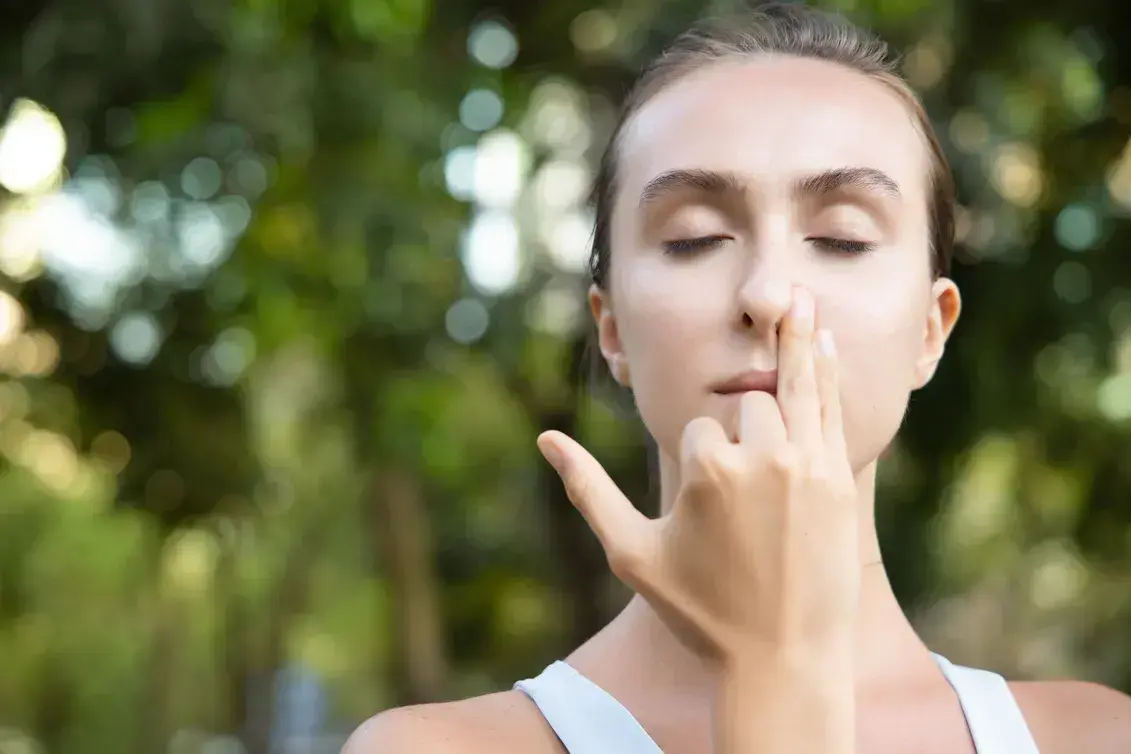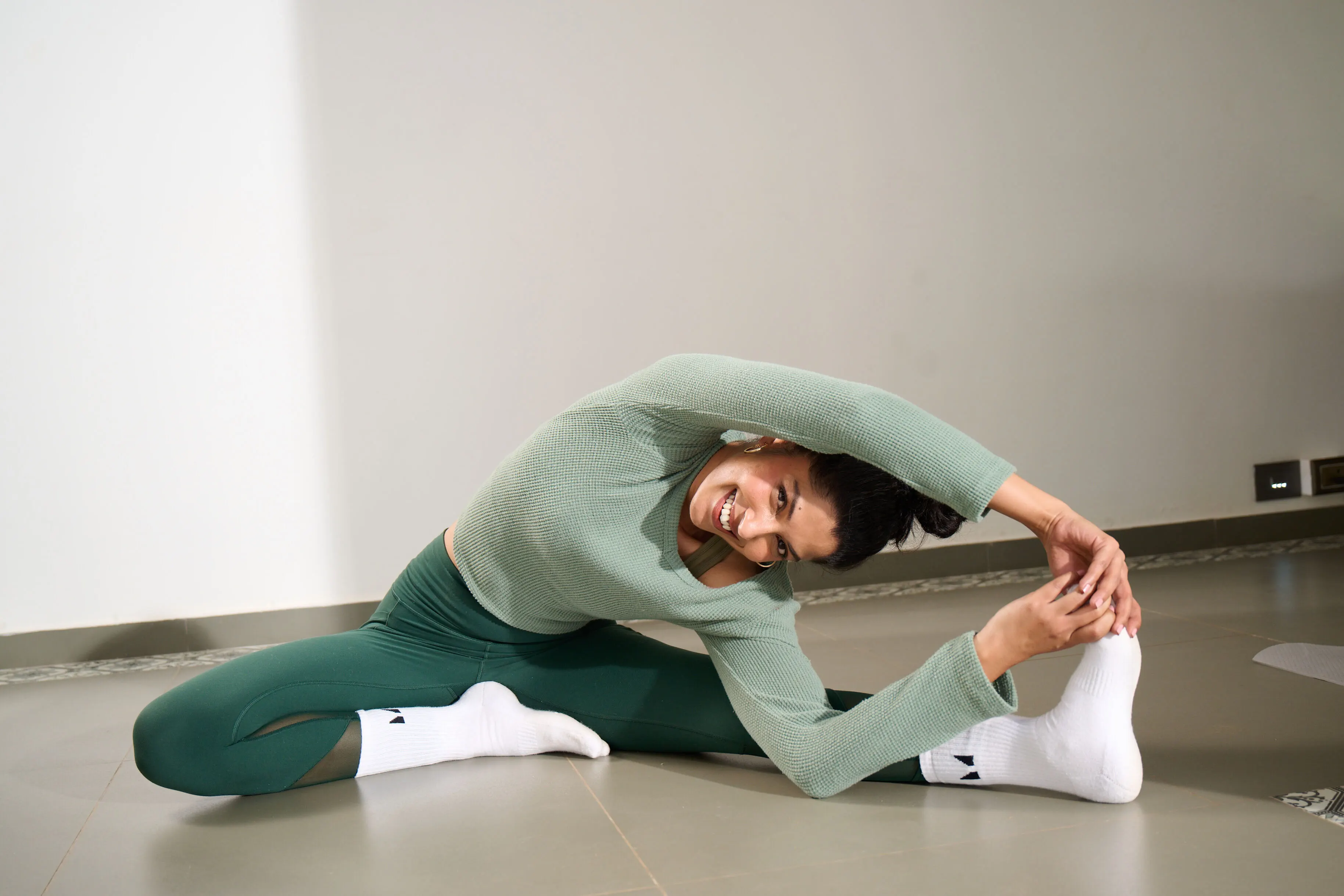What is the Baby Grasshopper Pose?
The Baby Grasshopper Pose is a beginner-friendly variation of the full Grasshopper Pose. It combines a twist, a balance, and a gentle arm engagement, making it an excellent introduction to arm balances. In this pose, the body is supported on one hand while the opposite leg is extended out, creating a sense of groundedness and lightness. It helps build core strength, improves flexibility in the hips and hamstrings, and enhances overall balance. Additionally, the pose encourages mental focus and resilience as it requires both physical strength and concentration.
Position type: Arm strength and balance
Posture type: Balancing
Ideal for: Strength
Targets: Arms, shoulders, hips
Pose level: Intermediate
How to prepare for the Baby Grasshopper Pose?
- Hip Flexibility: Open the hips with poses like Pigeon Pose (Kapotasana), Lizard Pose (Utthan Pristhasana), and Butterfly Pose (Baddha Konasana). These will help increase mobility and make it easier to cross the legs in the twist.
- Twisting Poses: Incorporate twists to prepare the spine and obliques. Practice Half-lord of the Fishes Pose (Ardha Matsyendrasana), Revolved Triangle Pose (Parivrtta Trikonasana), and Revolved Chair Pose (Parivrtta Utkatasana) to deepen your twisting capability.
- Core and Arm Strength: Build core and arm strength with poses like Boat Pose (Navasana), Plank Pose, and Four-Limbed Staff Pose (Chaturanga Dandasana). These will help support the lift and balance in Baby Grasshopper.
- Balance and Coordination: Improve balance with standing poses like Half Moon Pose (Ardha Chandrasana) and Tree Pose (Vrksasana). These will enhance your stability and coordination, essential for holding the Baby Grasshopper Pose.
How to do the Baby Grasshopper Pose? Getting into the posture:
- Sit on your mat with your legs extended. Cross your right ankle over your left thigh, creating a figure four shape.
- Place your left hand on the mat beside your left hip. Inhale, lengthen your spine, and as you exhale, twist your torso to the left, bringing your right elbow to the sole of your right foot.
- Place both hands on the mat, shoulder-width apart, slightly in front of your hips. Your right hand should be in line with your right foot, and your left hand slightly forward.
- Shift your weight forward onto your hands, engaging your core. Lift your hips off the mat while keeping your right foot hooked over your left thigh.
- Straighten your left leg out to the side, keeping it parallel to the floor. Engage your core and press firmly into your hands.
- Maintain the pose for a few breaths, keeping your gaze forward and your core engaged.
Getting out of the posture:
- To release, gently lower your hips back to the mat, uncross your legs, and return to a seated position before repeating on the other side.
Key Alignments for Baby Grasshopper Pose:
- Ensure your hands are shoulder-width apart and firmly planted on the mat. Your fingers should be spread wide, with your right hand aligned with your right foot and your left hand slightly forward to provide stability and support.
- As you twist, make sure your torso is fully rotated, with your right elbow pressing into the sole of your right foot. Engage your core muscles to maintain stability and balance as you lift your hips and extend your left leg.
- Keep your extended left leg parallel to the floor, with toes pointed or flexed. Your right foot should remain firmly hooked over your left thigh, creating a stable base for the twist and balance.
What are the benefits of the Baby Grasshopper Pose? The Baby Grasshopper Pose strengthens the core, arms, and shoulders, enhancing upper body strength and stability crucial for balancing poses. The pose improves hip flexibility and mobility by stretching the hip flexors and outer thighs. It also encourages spinal rotation and alignment, which helps increase the range of motion and improve overall posture. Additionally, Baby Grasshopper Pose enhances mental focus and concentration as it requires a balance of physical strength and mental clarity. Practicing this pose can build confidence in performing more advanced arm balances and improve overall body coordination.
What are the contraindications of the Baby Grasshopper Pose? The Baby Grasshopper Pose should be avoided by individuals with wrist or shoulder injuries, as it places significant weight on the hands and shoulders. Those with lower back issues or herniated discs should be cautious, as the twisting and lifting can exacerbate discomfort. Pregnant women or those with severe hip or groin injuries should also steer clear of this pose. If you have recent abdominal surgeries or are experiencing severe abdominal pain, consult a doctor before attempting it. Always listen to your body and modify or skip the pose if you experience any discomfort or strain.What are the counterposes of Baby Grasshopper pose? Practice Child’s Pose or the Staff Pose for a few minutes after doing Baby Grasshopper pose. Relax in these postures by taking a few deep breaths. Variations of Baby Grasshopper PoseEasy Variation:
- Place a block or bolster under your hips to provide extra support and reduce the load on your hands and shoulders. This helps you maintain balance and focus on the hip opening and twisting aspects of the pose.
- Instead of fully extending the left leg, keep it bent and closer to your body while lifting your hips. This modification reduces the intensity and helps you build strength and balance gradually before progressing to the full pose.
Advanced Variation:
- Full Grasshopper or Dragonfly Pose (Parsva Bhuja Dandasana): From the Baby Grasshopper Pose, extend your top leg (the left leg in this case) parallel to the floor and keep it straight. Fully engage your core and lift your hips higher, balancing on your hands and one leg while reaching your extended leg out to the side. This variation requires more strength and flexibility.
- Baby Grasshopper with a Bind: While in the Baby Grasshopper Pose, use your top hand to reach behind your back and grasp your bottom foot or ankle. This variation adds a deeper twist and shoulder stretch, intensifying the pose and requiring increased flexibility and balance.
Advice for Beginners: For beginners attempting the Baby Grasshopper Pose, start by focusing on building core strength and improving hip flexibility through preparatory poses. Use props like blocks or bolsters for support and to ease into the pose gradually. Practice twisting and balancing poses separately to develop the necessary stability and alignment. It’s important to listen to your body and avoid pushing into discomfort or strain. Remember, mastering balance and strength takes time, so be patient and consistent with your practice. Always learn how to practice under the guidance of a yoga teacher. Shvasa Tips:
- Maintain strong core engagement throughout the pose to support your balance and stability. This helps to lift your hips and keep your extended leg parallel to the floor.
- Ensure proper hand placement and alignment by spreading your fingers wide and pressing firmly into the mat. Keep your torso twisted and aligned with your bent leg, and avoid collapsing into your shoulders.
- Incorporate props like blocks or bolsters under your hips to provide extra support and stability. This can help you focus on proper alignment and build strength gradually without straining.
Learn how to practice the Baby Grasshopper Pose as well as preparatory poses that work towards improving arm, shoulder and core strength LIVE on Shvasa. Meta Description: Learn how to practice Baby Grasshopper Pose with steps, benefits, contraindications and modifications. Summary: The Baby Grasshopper Pose is a beginner-friendly variation of the full Grasshopper Pose. It combines a twist, a balance, and a gentle arm engagement, making it an excellent introduction to arm balances.FAQs:
- What is the Baby Grasshopper Pose?
The Baby Grasshopper Pose is a beginner-friendly variation of the full Grasshopper Pose. It combines a twist, a balance, and a gentle arm engagement, making it an excellent introduction to arm balances. It helps build core strength, improves flexibility in the hips and hamstrings, and enhances overall balance. Additionally, the pose encourages mental focus and resilience as it requires both physical strength and concentration.
- What are the benefits of the Baby Grasshopper Pose?
The Baby Grasshopper Pose strengthens the core, arms, and shoulders, enhancing upper body strength and stability crucial for balancing poses. The pose improves hip flexibility and mobility by stretching the hip flexors and outer thighs. It also encourages spinal rotation and alignment, which helps increase the range of motion and improve overall posture.
- What are the contraindications of the Baby Grasshopper Pose?
The Baby Grasshopper Pose should be avoided by individuals with wrist or shoulder injuries, as it places significant weight on the hands and shoulders. Those with lower back issues or herniated discs should be cautious, as the twisting and lifting can exacerbate discomfort. Pregnant women or those with severe hip or groin injuries should also steer clear of this pose.
- How to do the Baby Grasshopper Pose?
- Sit on your mat with your legs extended. Cross your right ankle over your left thigh, creating a figure four shape.
- Place your left hand on the mat beside your left hip. Inhale, lengthen your spine, and as you exhale, twist your torso to the left, bringing your right elbow to the sole of your right foot.
- Place both hands on the mat, shoulder-width apart, slightly in front of your hips. Your right hand should be in line with your right foot, and your left hand slightly forward.
- Shift your weight forward onto your hands, engaging your core. Lift your hips off the mat while keeping your right foot hooked over your left thigh.
- Straighten your left leg out to the side, keeping it parallel to the floor. Engage your core and press firmly into your hands.
- Maintain the pose for a few breaths, keeping your gaze forward and your core engaged.
- To release, gently lower your hips back to the mat, uncross your legs, and return to a seated position before repeating on the other side.















.jpg)











%201.png)

%201.svg)






%201.svg)